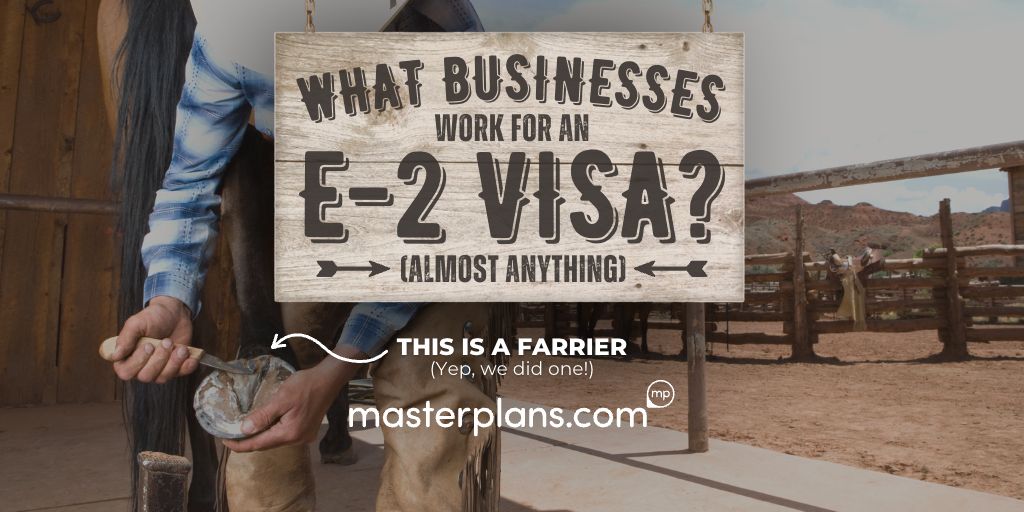How to Write a Management Summary for Your Business Plan
Entrepreneurs are often celebrated for their uncanny ability to understand others – their customers, the market, and the ever-evolving global...
5 min read
![]() William Dean
Dec 14, 2022 8:34:31 AM
William Dean
Dec 14, 2022 8:34:31 AM

There’s a lot to love about the E-2 visa. It’s available to citizens of more than 80 treaty countries. There’s no annual cap limiting how many overseas investors can pursue it. It does not have fixed investment requirements, or sky-high funding and job creation demands like the EB-5. It typically lasts for 3-5 years, and as long as the subject business stays open, the visa can be renewed indefinitely. A foreign national can partner with a U.S. citizen. In some scenarios, an E visa can be converted into other types of visas. The lead investor’s role isn’t meticulously dissected during adjudication the way it is for intracompany transferees. You can buy a qualifying business – including a franchise, guaranteed to meet E-2 criteria – or start one on your own. The E-2 even confers employment and other benefits to an investor’s spouse and children. In the hands of qualified counsel, it’s relatively easy to obtain. What’s not to like?
Okay, the E-2 is a nonimmigrant visa, and doesn’t grant investors a green card. Furthermore, there are unfortunately billions of people from India, China, Brazil, Russia, and elsewhere who can’t qualify without another passport or expensive CBI path (hello, Grenada!). But overall, this is a rockstar visa – clear-cut, accessible, flexible. It accounts for the lion’s share of our immigration business plan clients, and it’s the bread-and-butter service for hundreds of great lawyers we know. I talk to at least one prospective E-2 client every day, and in general they’re well-prepared and eager to proceed with the important work of drafting a business plan to support their case. Oftentimes, these applicants are new to entrepreneurship, and the business plan we make is useful to them as a roadmap for operations, not just rote petition filler.
My favorite thing about the E-2, as a business plan writer, is the variety. Whereas the majority of EB-5 matters concern real estate, and it seems like every other L-1 beneficiary works for an import/export business, the E-2 landscape is like walking down the candy aisle in a grocery store. For every gas station or coffee shop, we also get to write about a racquetball gym, a geolocation app, a vegan bakery, a car racing circuit, a dog training school, you name it – if it’s federally legal (sorry, dispensary hopefuls), it’s fair game.
We even wrote a (successful!) E-2 plan for a farrier this year (if you had to click to look that one up it’s okay, I did too). There’s been a serious upswing in real estate-oriented E-2s, which can be tricky to prepare well, but in aggregate our E-2 clientele still delivers a carousel of business models new and old.
Looking back to summer, here’s a sampling of the last 100 E-2 plans we’ve handled at Masterplans, by industry sector. This is an unscientific snapshot, and not necessarily indicative of the breakdown that consular officers or USCIS sees, but it was sure fun to make:

As you can see, restaurants, real estate development, and trucking companies are well represented, and one in every five was a unique business or personal service. But bottom line, the fact “All Others” is far and away the largest category makes my point in a nutshell.
If you want an idea of what the U.S. business landscape is like, just look to the thousands of E-2 visa investors who come here every year to grow the economy.
Their unique ideas and efforts create tax revenue and employment opportunity in every sector and every state. I always tell prospective clients: the E-2 isn’t explicitly a job-creation program the way EB-5 is, but it functions much the same way. And we collectively reap those benefits here in the U.S. every single day.
The core elements behind a great E-2 plan are making it crystal clear that A) the investor’s funds are sufficient for the business they’re planning to run, B) there should be some U.S. job creation within approximately 12-18 months after startup, and C) the applicant is at least reasonably well-suited to the enterprise. Attorneys refer to these first two issues as proportionality (literally, is the planned investment proportional to what would be expected for this type of company?) and marginality (will the company be non-marginal, i.e., doing more to boost the U.S. economy than simply supporting its principal investor and his or her family?).
To get more insight about these critical E-2 touchstones and other important issues for E-2 visa seekers, I talked to Belma Demirovic Chinchoy, a longtime immigration lawyer at the Los Angeles firm of Iyer Demirovic Chinchoy LLP:
“In evaluating a new E-2 case, I first consider two things: 1 ) how well developed is the business idea, and 2) whether the investor possesses an expertise and/or experience with this line of work. Through this discussion, I can get a good sense of the investment proportionality and whether the business leans toward being marginal. Most traditional business models will perform well if the petition is carefully prepared, but in my experience, entertainment/influencer/app development types of businesses – especially those led by very young professionals – tend to be scrutinized the most by E-2 adjudicators. Officers do not take these businesses as seriously, so these types of E-2 filings have to be heavily substantiated and the investors need to be well prepared for the interview.
“We have seen investors prepare aggressive business plans in terms of revenue and employment creation (i.e., aiming to preempt a finding of marginality), but then make initial cash investments that fall well short of supporting such lofty business development and hiring plans. USCIS pushes back in these cases, and questions business feasibility and credibility of the business plan. These plans tend to be home-grown and not supported by third parties or market data, which is why I insist clients work with outside professionals like you guys.”
As business plan writers, we at Masterplans have a set of market research tools we can turn to for help proving proportionality and marginality. There’s no substitute for experience, and one of the most useful data sets we have at our fingertips is a vast collection of 20,000+ financial models built for startups and existing businesses nationwide seeking SBA-backed lending or angel investment. We also pay for subscription-based resources that compile industry average rates for various expenses (including employee salaries), which can prove extremely useful to cross-reference payroll and Use of Funds figures, even in these less traditional business models which tend to invite scrutiny. (For the DIY crowd, there are some free tools out there too, like salary.com and the U.S. Census Bureau, which offer reports that can be used to confirm estimates for some clients or at least help inform basic forecasting.)
Beyond just proportionality and marginality concerns, I was also curious about the differences – from a lawyer or client’s perspective – in a petition submitted directly to USCIS as opposed to an embassy or consulate. Belma shared these observations:
“As a preliminary matter, it is essential to submit comprehensive E-2 packages to both USCIS and a consulate which address all E-2 legal requirements. What distinguishes the filings to USCIS and a consulate, generally speaking, is that filings to USCIS are more detailed with lengthier exhibits. Filings to USCIS do not have a page limit and USCIS expects to see a substantial amount of detail in organizational charts, job descriptions, and financial projections. The flip side of this is that USCIS does not have the opportunity to interview and hear from the investor, so the documents alone have to tell the story and substantiate it.
“Submissions to a consulate tend to be more formulaic – in accordance with the specific instructions provided by the receiving consulate – and a comprehensive business plan is generally the most significant document in an E-2 submission to the consulate or embassy. To me, that makes a good business plan even more important, despite the fact there’s an opportunity for the candidate to be interviewed about the business.”
Belma also cautions that one common pitfall of E-2 filings, especially at consulates, is presenting an overly complicated plan or ownership structure that a consular officer cannot make sense of in the very limited time they have to adjudicate the application. Consular filings have to make it crystal clear that all E-2 legal requirements have been met, without wasting time on distractions or dragging the reviewer into a labyrinthine explanation of how different business elements interrelate.
“A clear, concise business plan is the best way to avoid this confusion,” Belma reassures us. “Based on trends I’ve witnessed the past few years, it will be even more important to make the adjudicator’s job easy in 2023.”

Entrepreneurs are often celebrated for their uncanny ability to understand others – their customers, the market, and the ever-evolving global...

Despite growth in sectors like artificial intelligence, venture capital funding has seen better days. After peaking at $347.5 billion in 2021, there...

Most people think of a professional business plan company primarily as a "business plan writer." However, here at Masterplans, we choose to approach...